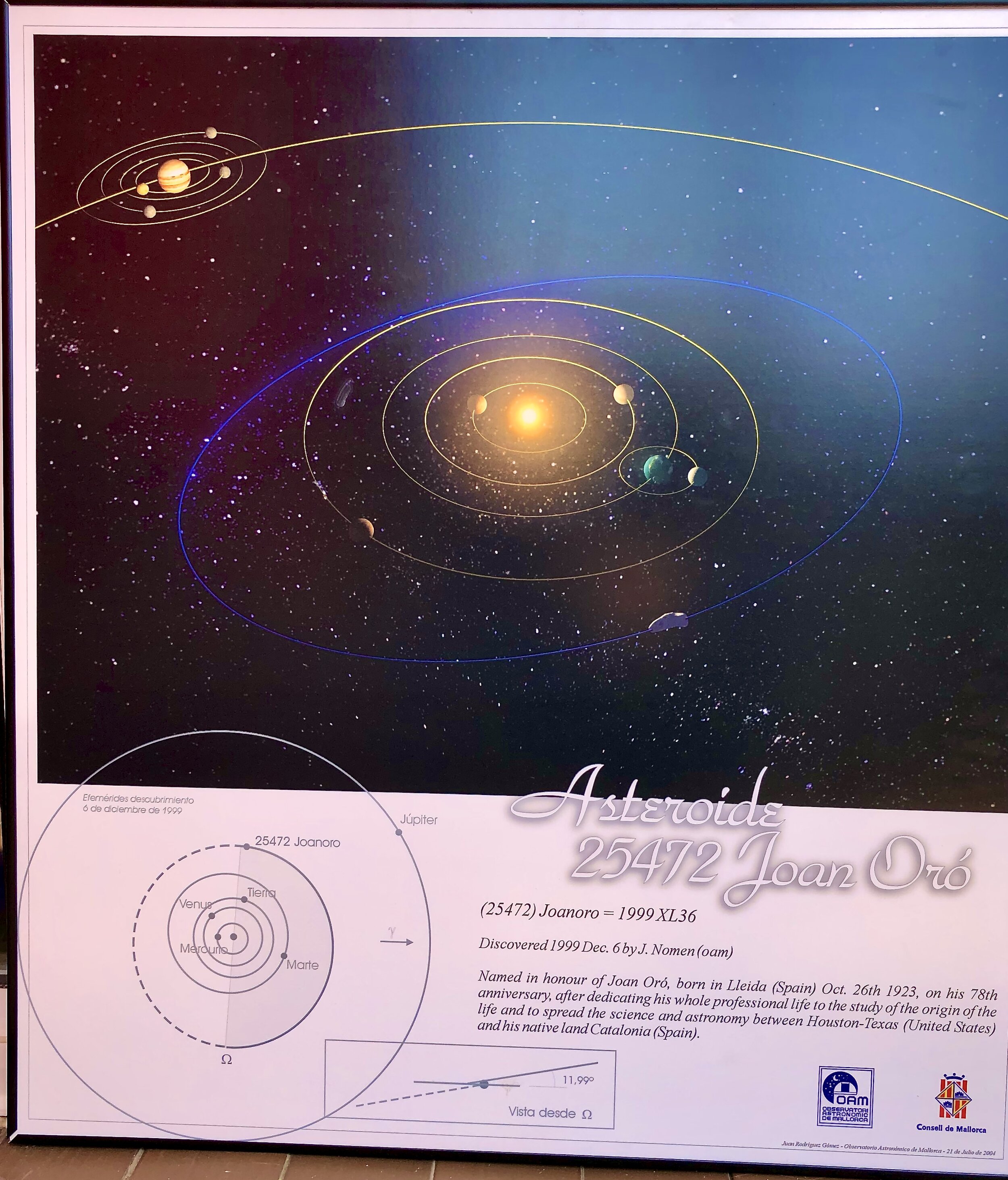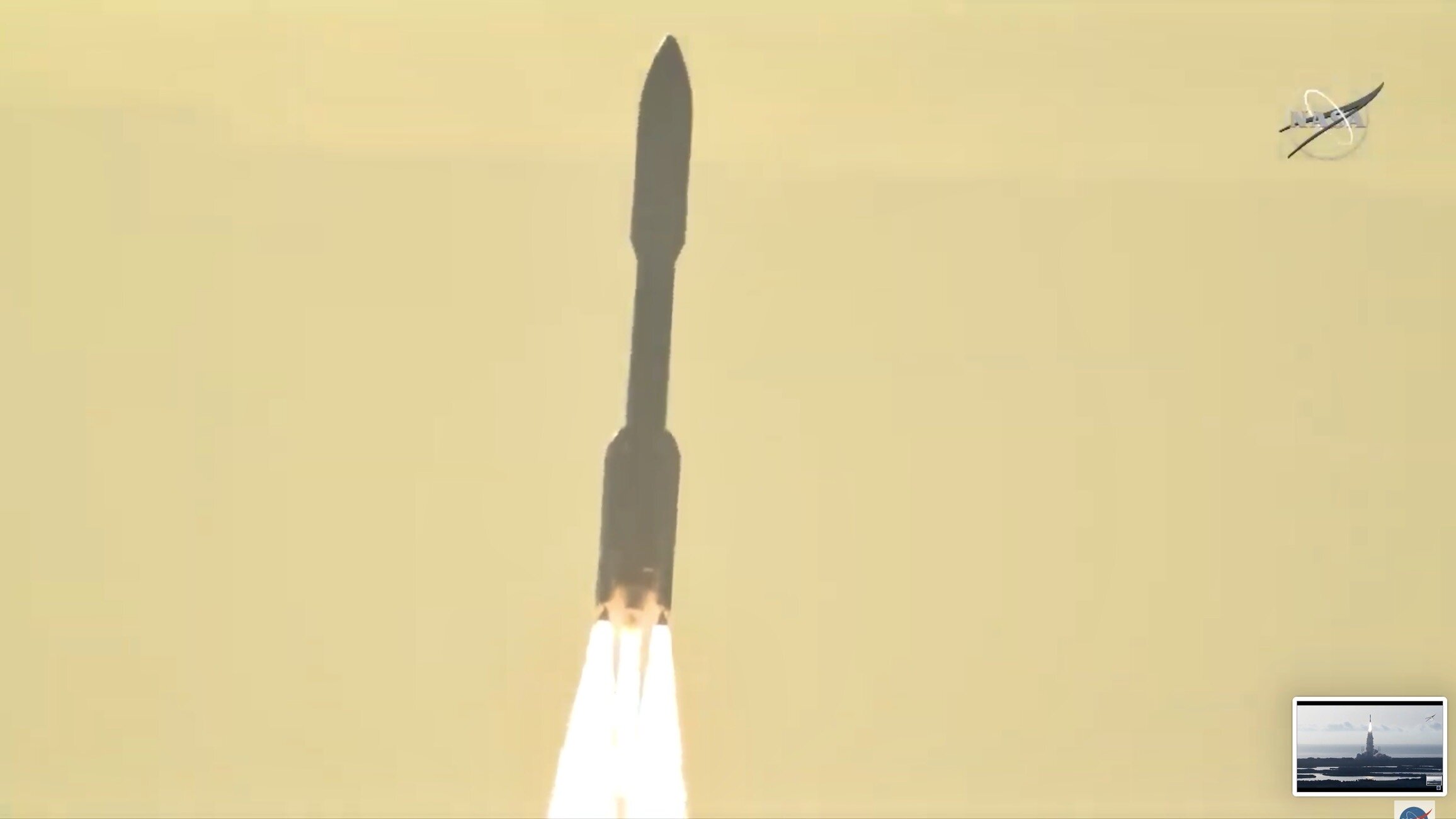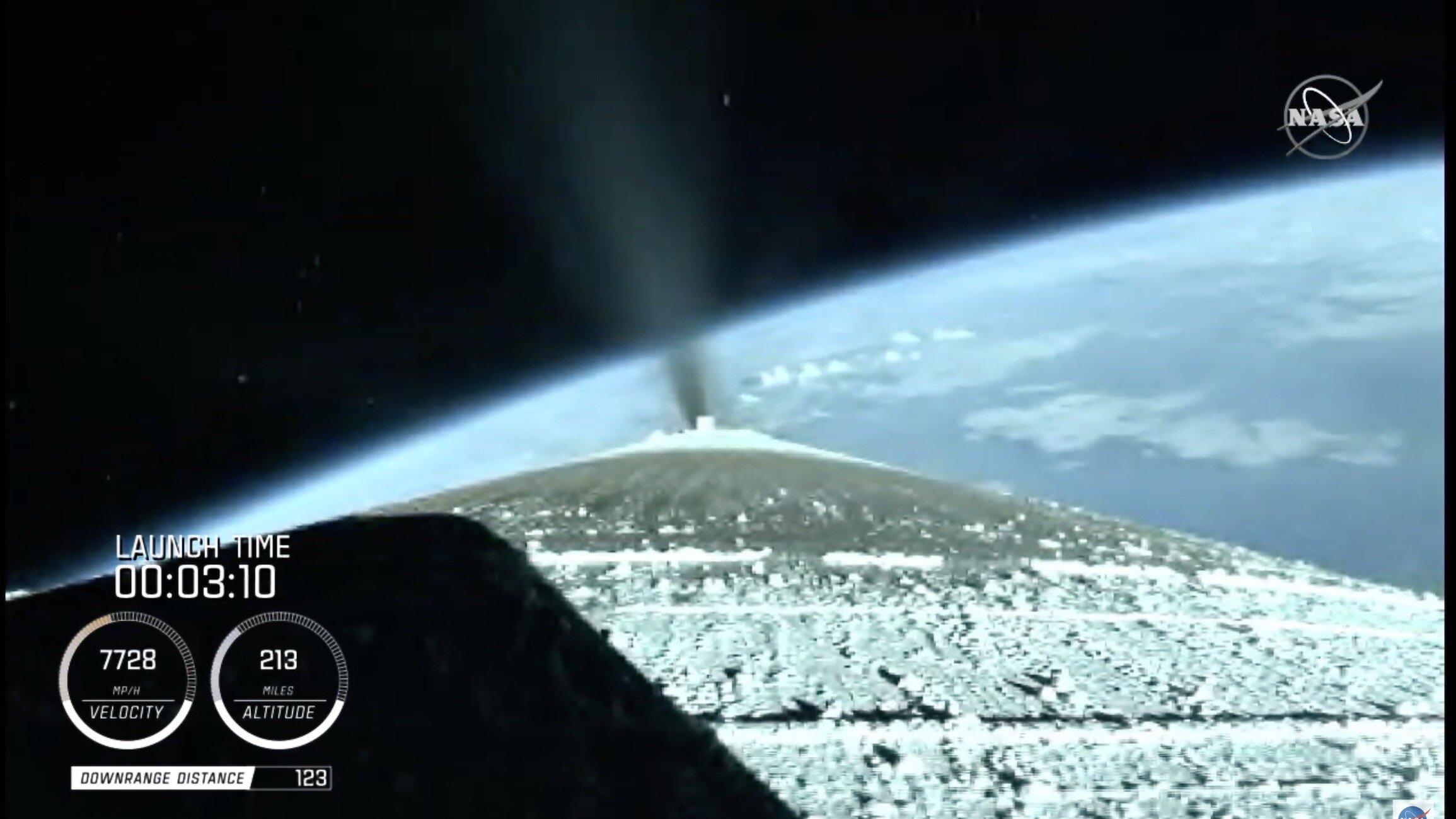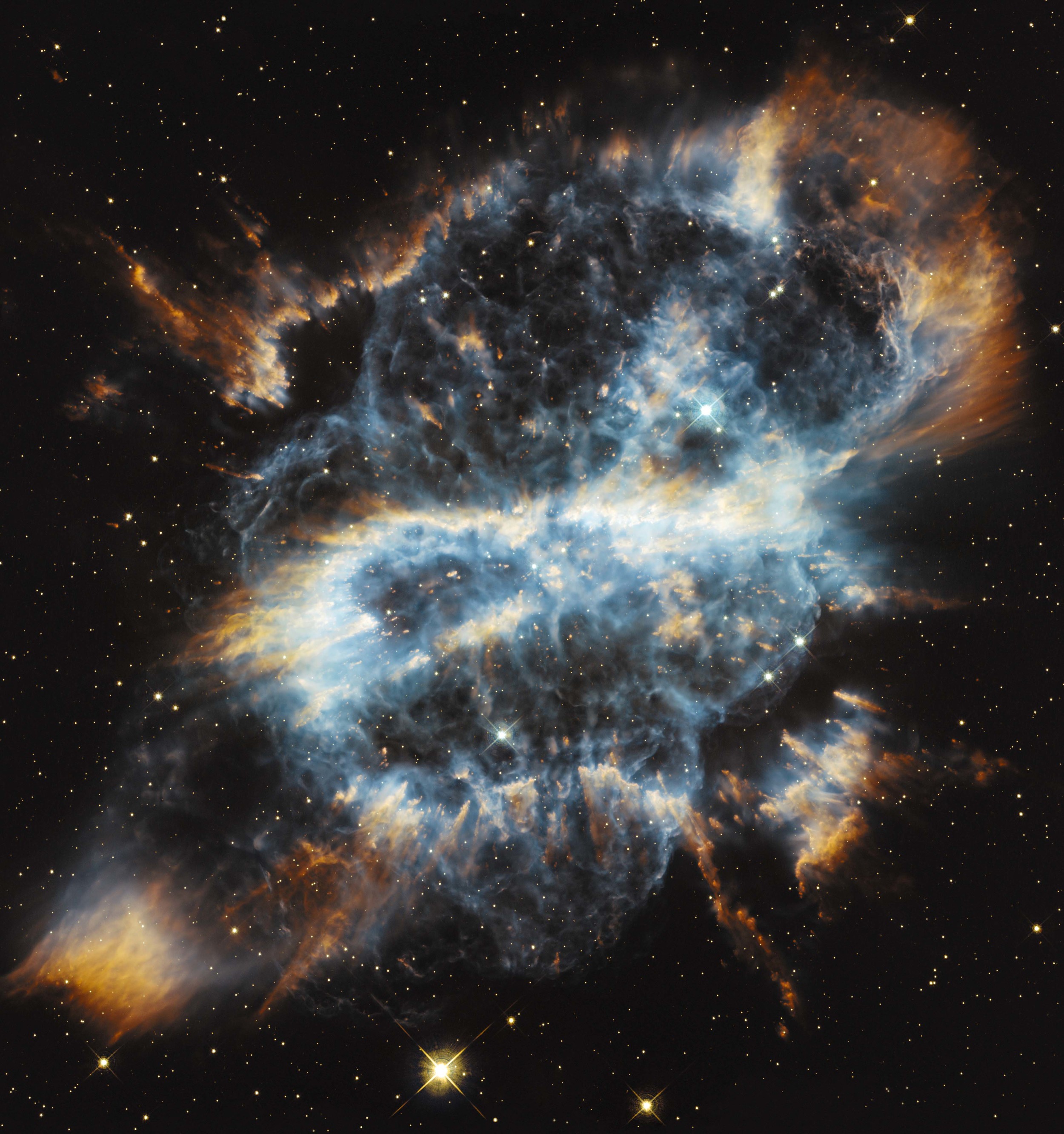Asteroid 25472 Joan Oró. This main-belt asteroid (seen in the bright blue line), discovered in 1999, was named after Dr. Joan Oró for having dedicated "his whole professional life to the study of the origin of life and to spread the science and astronomy between Houston-Texas (United States) and his native land Catalonia (Spain)."
PHOTOS: MARS 2020 DEPARTS EARTH FOR THE RED PLANET
IGNITION: MARS 2020 lights up at Cape Canaveral Air Force Station on Mission to the Red Planet.
LAUNCH: Great weather for a spectacular launch of MARS 2020. “Go Atlas, Go Centaur, Go Mars 2020”
Atlas V rocket with a Centaur RL10 upper stage booster escapes Earth’s gravity. Tucked within the Centaur nose cone is the Perseverance Rover and a specialized light helicopter, Ingenuity.
At 46 seconds, Atlas V accelerating to Mach 1 supersonic speed.
Aircraft at max dynamic pressure.
Traveling at 6000 mph, Atlas V jettisons Solid rocket boosters.
Atlas V throttling to constant 2.5G acceleration for payload jettison.
With Atlas V engine cut off, Centaur booster separates from Atlas.
With its herculean mission accomplished, Atlas V drifts away. the Centaur booster will soon fire. monitoring of the mission will continue using space tracking video.
At a height beyond camera range, the Centaur booster with Perseverance at its tip is tracked using space tracking video generated “by actual telemetry data.”
The Centaur booster releases Perseverance injecting it into an interplanetary trajectory to Mars. Travel time: 7 months.
Related Content:
44 YEARS AGO TODAY: VIKING 1 LANDED ON MARS IN SEARCH OF LIFE
"An astonishingly fragile film"
Dr. Piers Sellers knows the Earth’s atmosphere. After obtaining a bachelor’s degree in ecological science and a doctorate in biometeorology in England, Dr. Sellers studied the interaction between the Earth’s biosphere and atmosphere at NASA Goddard Space Flight Center in Maryland.
Dr. Sellers then became an astronaut and flew in three shuttle missions to the International Space Station stationed in the thin atmospheric layers 180 – 190 miles above Earth.
With 80% of the atmosphere within 10 miles of the Earth’s surface, traveling a mere 60 miles an hour, we would drive through this rich layer in 10 minutes. As Dr. Sellers observed in Leonardo DiCaprio’s recent film Before the Flood, “an astonishingly thin layer” nourishes us.
The Cosmos Revealed: A comet
In-your-face close-up taken by the Rosetta spacecraft after performing an “extreme maneuver” to get within 3.7 miles of Comet 67P/Churyumov–Gerasimenko.
LANIAKEA: Immeasurable Universe
Scientists studying the motion of the galaxies in our region of the universe have found some are being pulled towards us while others are being pulled away. Our local cluster of galaxies is part of a supercluster believed to be 100 million light years across. Through these gravitational studies, scientists have radically altered the map of our supercluster (show above) and found it to be more than 100 times larger than previously thought. Our home, the Milky Way (red dot), is nestled in our supercluster, recently christened Liniakae, Hawaiian for Immeasurable Universe.
Space weather: Know your solar flares
M-class solar flare. NASA's Solar Dynamics Observatory
“Scientists classify solar flares according to their x-ray brightness in the wavelength range 1 to 8 Angstroms. There are 3 categories: X-class flares are big; they are major events that can trigger planet-wide radio blackouts and long-lasting radiation storms. M-class flares are medium-sized; they can cause brief radio blackouts that affect Earth’s polar regions. Minor radiation storms sometimes follow an M-class flare. Compared to X- and M-class events, C-class flares are small with few noticeable consequences here on Earth.”
Sources
Related post: Coronal Mass Ejection of 1859
Coronal Mass Ejection of 1859
NASA illustration.
"This massive CME released about 1022 kJ of energy - the equivalent to 10 billion Hiroshima bombs exploding at the same time - and hurled around a trillion kilos of charged particles towards the Earth at speeds of up to 3000 km/s. However, its impact on the human population was relatively benign as our electronic infrastructure at the time amounted to no more than about 124,000 miles (200,000 km) of telegraph lines.
Mr Dale makes it clear in the latest issue of Physics World that these types of events are not just a threat, but inevitable.
Nasa scientists have predicted that the Earth is in the path of a Carrington-level event every 150 years on average."
Solar flare May 27, 2014
Image: Solar Imagery Center
This small C-class solar flare on May 27, 2014 was pulled back into the sun by gravity. Occurring almost daily, C-class flares have little effect on Earth yet provide a tremendous sight as imaged by the NASA - Solar Dynamics Observatory.
Extreme closeup: Sunspot
Image: NSO Dunn Solar Telescope, courtesy of Thomas Rimmele
SpaceX rocket booster soft-lands in Atlantic
Image: SpaceX
SpaceX reports a breakthrough in spaceflight - the soft-landing in the Atlantic of the Falcon 9 rocket booster that recently launched a Dragon supply capsule to the International Space Station. According to Mashable, SpaceX CEO Elon Musk commented on the event:
"I'm happy to confirm that we were able to do a soft landing in the Atlantic and all the data received back is that it made a soft landing and was in a healthy condition after that.”
However, a large storm was raging at the landing site and "the boost stage was subsequently destroyed by wave action."
Learn more: SpaceX Successfully Soft-Landed Booster Rocket in the Atlantic
Jets of water vapor & ice on Saturn's moon Enceladus
Water & ice spewing from Saturn's moon Enceladus in this 2005 Cassini spacecraft image. Credit: NASA/JPL/SSI; Mosaic: Emily Lakdawalla
"Ever since the Cassini spacecraft first spied water vapor and ice spewing from fractures in Enceladus’ frozen surface in 2005, scientists have hypothesized that a large reservoir of water lies beneath that icy surface, possibly fueling the plumes. Now, gravity measurements gathered by Cassini have confirmed that this enticing moon of Saturn does in fact harbor a large subsurface ocean near its south pole."
Learn more: Cassini Spacecraft Confirms Subsurface Ocean on Enceladus
"Might just be the most extraordinary image you have ever seen."
"Although it might not seem like much, the photo above might just be the most extraordinary image you have ever seen. Not because of crazy high megapixel count or amazing composition or even subject matter — we’ve seen images of planets orbiting stars before — but because it is the first ever image of a planet and its star over 63 light years away."
Behold the First Ever Image of a Planet and Its Star Over 63 Light Years Away
"Acquired by the world's most powerful planet-hunting instrument, the Gemini Planet Imager, it shows a 10-million-year-old planet called Beta Pictorus orbiting its giant parent star. It's the first such image to come from Gemini, which has been under development for over a decade but is only now producing data like this."
Gemini's First Image Shows a Planet Orbiting a Star 63 Light Years Away
A Beautiful View of the Heavens
Hubble Space Telescope image of planetary nebula NGC 5189
Space: Beautiful rendering of oldest galaxy found
An artist’s rendering of galaxy BX442, which is 10.7 billion light-years from Earth, and its companion dwarf galaxy (upper left). CREDIT: Dunlap Institute for Astronomy & Astrophysics/Joe BergeronVia Space.com
Update: Dragon returns to Earth
Image: SpaceX/Michael Altenhofen
Congratulations to SpaceX & NASA. As noted in an earlier post, on Tuesday, May 22, 2012, Space Exploration Technologies (SpaceX) launched a cargo-carrying Dragon capsule on a Falcon 9 rocket to the International Space Station. Today, Dragon returned to Earth marking the successful completion of an historic mission.
Dragon docks with ISS: A new era dawns
Space X Falcon 9 rocket launch from Cape Canaveral. NASA.
On Tuesday, May 22, 2012, Space Exploration Technologies (SpaceX) successfully launched a Falcon 9 rocket carrying an un-manned Dragon capsule on a mission to International Space Station; an ambitious and groundbreaking event for a private company. Today, at 12:02 PM Eastern time, the Dragon capsule docked with the International Space Station (ISS) and a new era dawned.
On October 4, 1957, the world was startled by news that the U.S.S.R., “the Russian’s,” had sent an object, called a satellite, orbiting around the globe. Anxious Americans could see the blinking Sputnik circling overhead at night. On April 12, 1961, the U.S.S.R. put a man, cosmonaut Yuri A. Gargarin, inside a capsule at the top of a Vostok rocket and launched him into space, breaking the space barrier for humankind.
The U.S. quickly rallied and launched Alan B. Shepard, Jr. into space on May 5, 1961, and, on February 20, 1962, John H. Glenn, Jr. became the first American to orbit the Earth and the first man to complete three orbits.
Pushing forward, president John Kennedy launched an ambitious program to reach the moon by the end of the 1960’s. With Michael Collins piloting the Apollo Command Module in moon orbit, Neil Armstrong and Edwin Aldrin, Jr. descended to the moon in the Lunar Module. On July 20, 1969, they became the first humans to step on a celestial body beyond Earth.
The massive Apollo program transformed our world, but overtime became financially challenging and space exploration was refocused on robotic planetary missions.
The first component on the International Space Station was launched in 1998, and spacefarers began to arrive on the U.S. Space Shuttle and U.S.S.R. Soyuz. With the end of the shuttle program in July 2011, the Soyuz spacecraft became the only means of transport to ISS.
Into the breach entered a number of U.S entrepreneurs, among them Elon Musk. With a fortune made as co-founder of PayPal, Musk developed two ambitious projects: to travel to the planets and, in the available spare time, build an all-electric car that could travel 200-300 miles per charge. The Tesla Model S, the second electric car by Musk’s Tesla Motor Works, goes sale on next month.
ISS robotic arm attaches to SpaceX Dragon capsule. NASA.
Today, with the successful docking of the Dragon capsule, a more significant and fundamental step has been taken. One, that over time will be seen as the dawn of a new era - not just of space exploration, but for the extension of humankind into the heavens. Those pioneering U.S.S.R. cosmonauts and U.S. astronauts led the way. Astronomic and space agencies from many countries are surveying space and space telescopes, such as the marvelous Hubble, peer to edge of the visible universe. Modern entrepreneurs now have an opening to carry humankind into space, maybe even to the planets.
The new journey to the heavens begins today.





























